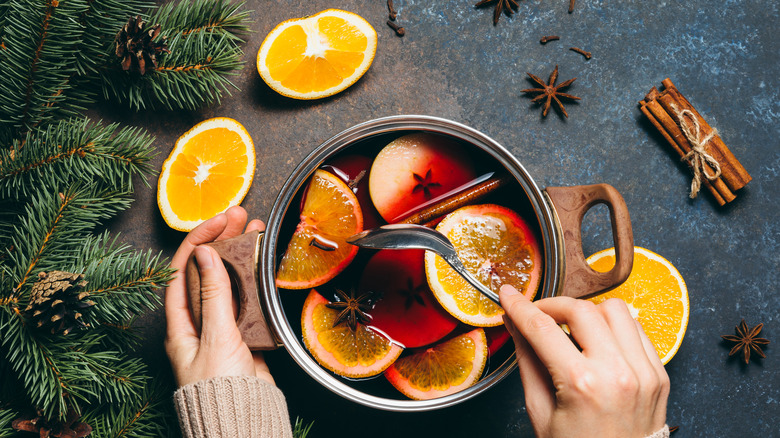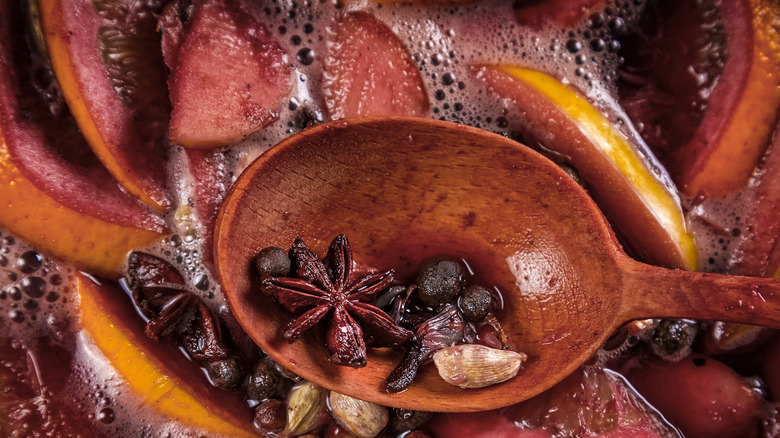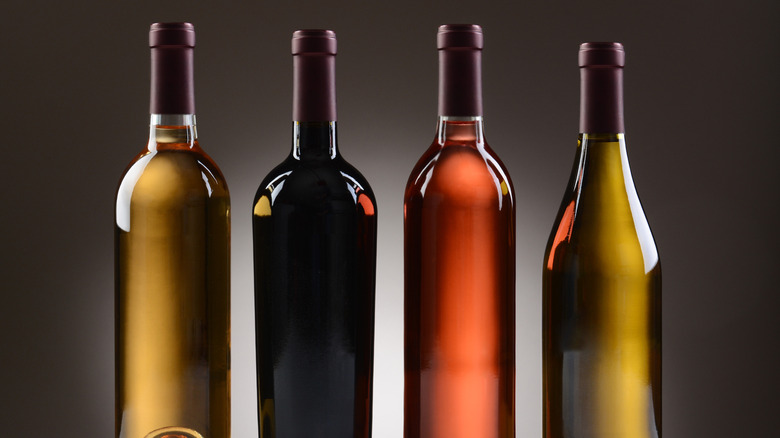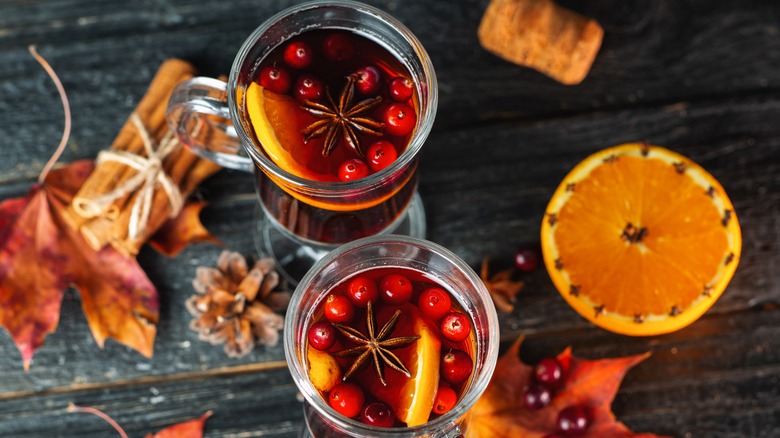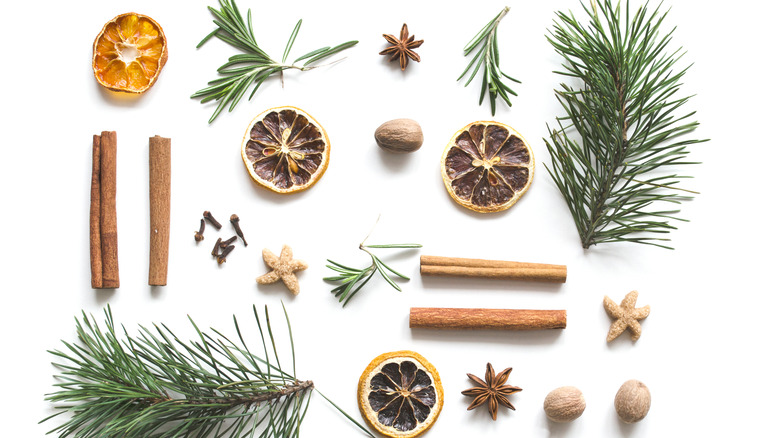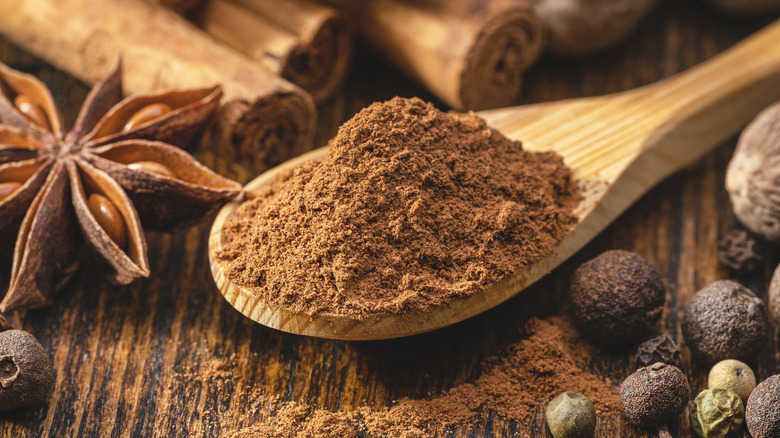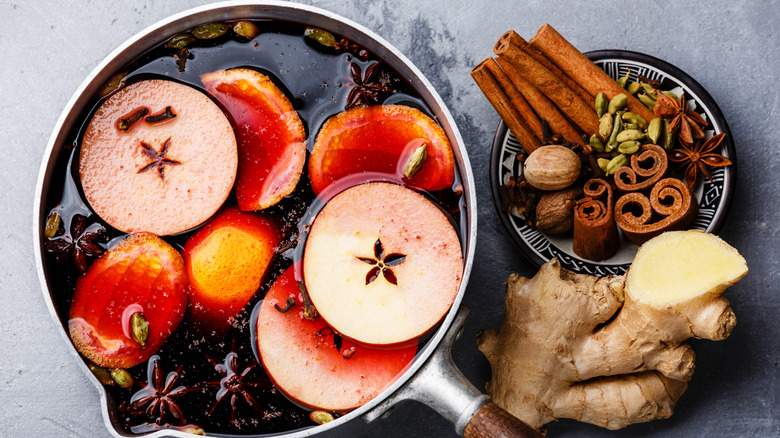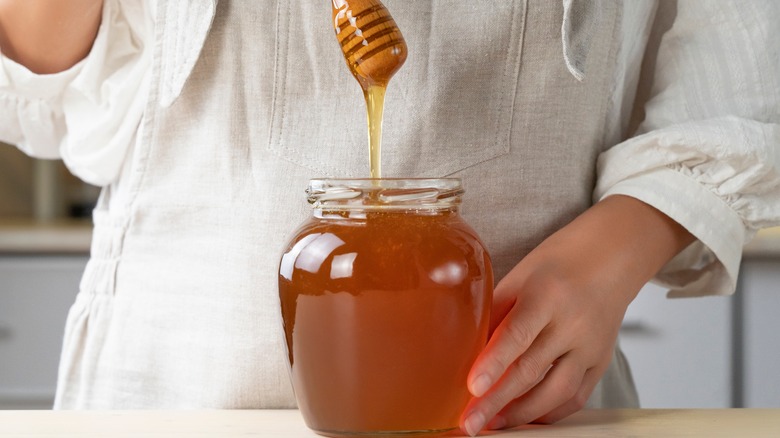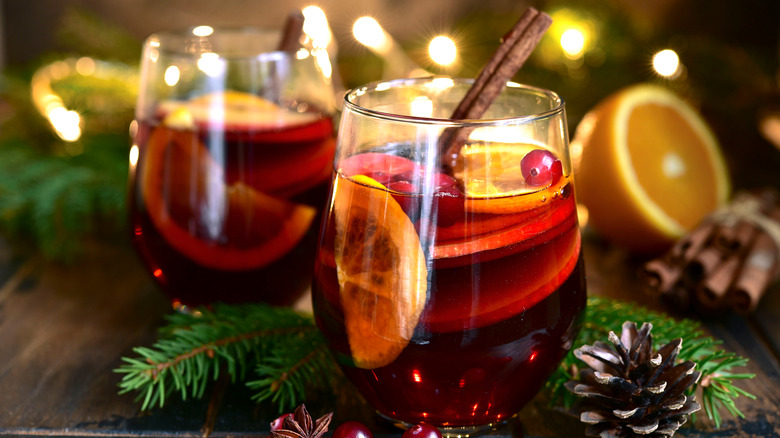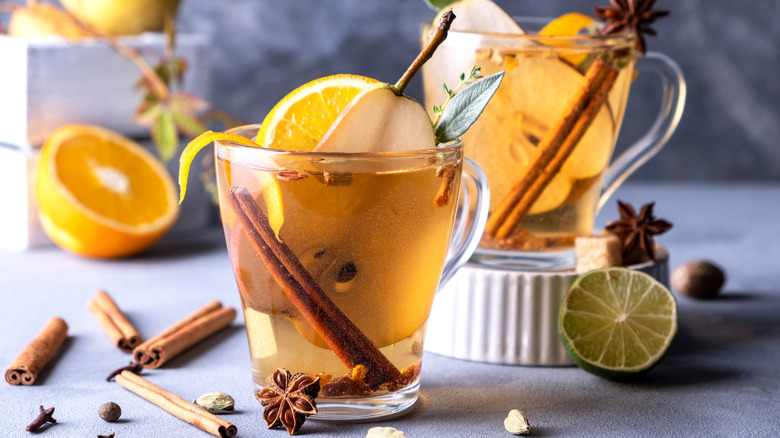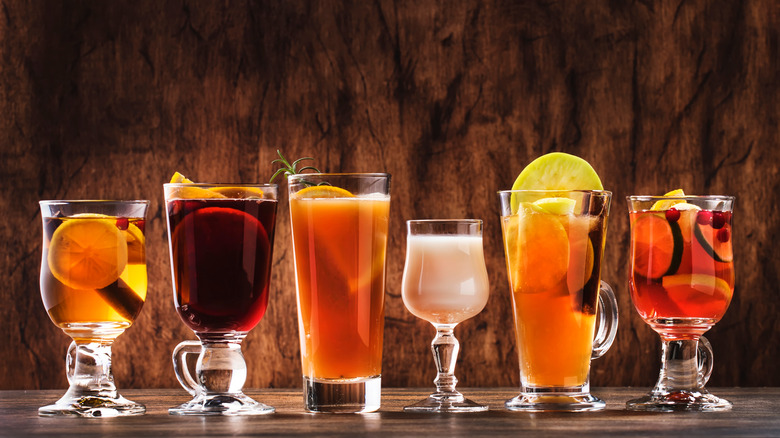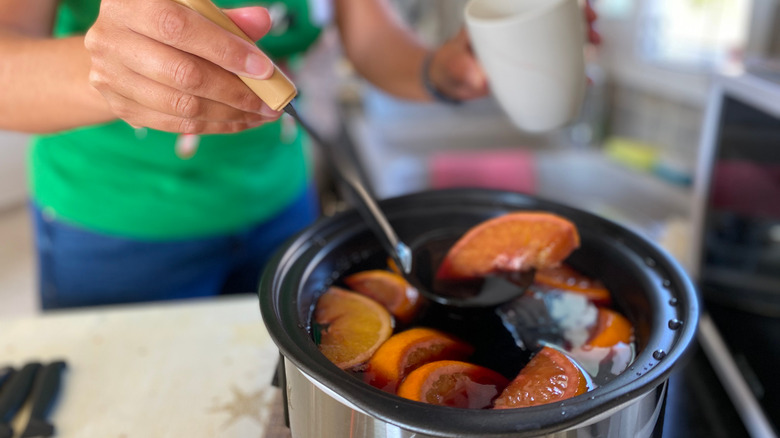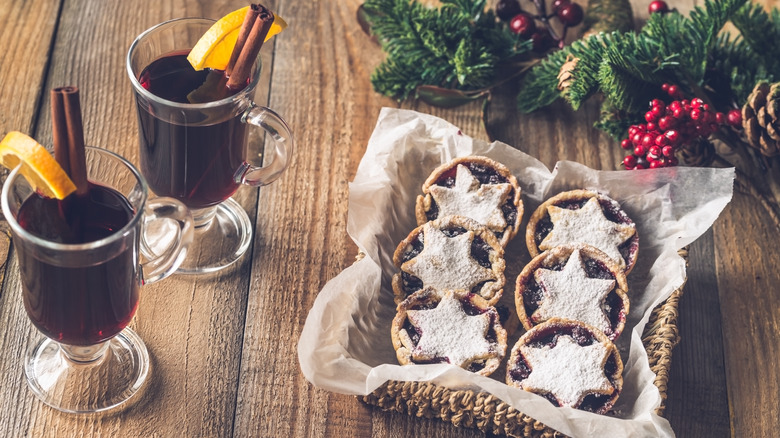12 Mistakes Everyone Makes With Mulled Wine
Holidays always call for something warm, spicy, and ultimately cozy, and mulled wine perfectly fits the description. A cup of wine mulled with aromatic spices served with citrus fruit, and preferably a shot of some potent spirit, makes a perfect wintertime drink. This soothing beverage has an ancient history dating back to the old Romans, and it somehow managed to survive to this day, with numerous international iterations that grace Christmas markets around the world (via Vinepair).
Making mulled wine is incredibly easy. This wintertime specialty is often whipped up at home as it makes a perfect addition to those chilly evenings that call for some contemplation and acts as a convenient communal option for all traditional holiday get-togethers ahead. However, many people don't approach mulled wine with respect, often believing that a questionable bottle of bottom-shelf red and a few old spices that have been sitting in your cabinet for too long will result in a successful cocktail. This approach has given mulled wine a bad rep, but it's high time we award this ancient beverage the respect it deserves.
We've rounded up the most common mistakes you can make with mulled wine. If you follow all the practical advice listed below, you will get a cup of perfectly mulled wine that will set everyone in a perfect holiday mood and make them forget about all those less-than-successful versions they had before.
1. You're boiling mulled wine
One of the most common mulled wine mistakes is letting the wine boil. To prepare mulled wine, you would fill a large pot with wine, lace it with spirits or liqueurs, flavor it with fruit, and spice it up with a selection of your favorite baking spices. It sounds fairly simple, but many things could go wrong here, and allowing mulled wine to boil is probably one of the most common mistakes avid mulled wine enthusiasts make. It can lead to an unpalatable, syrupy, and tart concoction that will not fill your soul with Christmas cheer.
If you allow your wine to boil, alcohol will slowly but surely evaporate, which is not what you want for your hot wine cocktail. Vine Pair reported on research conducted in 2007 by the U.S. Department of Agriculture that analyzed how much alcohol is lost in food preparation. The analysis covered several techniques, but the conclusion was that the longer you simmer any food that contains alcohol, the more alcohol will be lost, whereas adding alcohol into a hot liquid will leave you with 85% of alcohol inside your drink. So try to avoid lengthy cooking and preserve that precious alcohol in the pot.
The long boil can also negatively affect the flavor of your wine. As Matching Food and Wine explains, the longer you simmer mulled wine, the spices will impart more flavor, which is not always a good thing. It can throw things off balance and make the wine tart and bitter.
2. Using low quality wine
There is a common misbelief that the quality of a cooking wine will have little effect on the dish. The same theory sometimes extends to mulled wine, and both ideas couldn't be further from the truth. These ingrained misconceptions don't take into account that the wine delivers flavor. In mulled wine, it also makes the base and sets the framework, which is then slightly tweaked with spices and fruit. This is why you need to choose decent quality wine and one you enjoy drinking.
Don't only rely on the price as the determining factor. Plenty of great quality wines don't come with a high price tag, so look for value instead of cost. Alternatively, you don't want to go with the most expensive bottle on your shelf. Mulling a pricey Bordeaux or Barolo would be meaningless. These wines have plenty of body and character, and adding more flavor and spices seems pointless and could mess with the wine's already outstanding qualities (via Vine Pair).
According to The Guardian, the safest bet is to go with full-flavored red wines. They suggest powerful, full-bodied red varieties packed with flavors of red and dark fruit, such as Garnacha, Malbec, or Shiraz. Tempranillo, the flagship grape from Rioja, is also one of the good options for mulled wines.
3. You blindly stick to familiar spices and flavors in mulled wine
Cinnamon and cloves are the best spices for mulled wine — we can't argue against it, but why not spice it up a little and step back from all those standard choices that consistently deliver the same flavor? The world abounds with aromatic ingredients that would perfectly fit in a cup of mulled wine to enhance the warming flavor or balance the robust notes of baking spices.
Deepa Shridhar from Sicc Palette opts for an interesting combination of lime zest and tamarind water, which provide some sour and sweet nuances, along with ginger and peppercorn for a stimulating, peppery hint. In the book "Hot Toddies," Christopher B. O'Hara recommends several excellent additions to make this year's mulled wine different, better, or perhaps the best you've ever made. Along with other creative recommendations, the author suggest allspice as a suitable replacement for traditional baking spices and cardamom as a great option that provides a unique blend of sweet, spicy, and mint-like nuances.
4. You use old spices that have lost potency
Whichever spices you add to your holiday mulled wine, make sure that they are fresh, and replace all those satchels and packets that have graced your spice cabinets for too long. Like all things in life, spices tend to lose potency with age. While a spice blend that you have kept and used for three consecutive holiday seasons may not be completely devoid of flavor, you may want to replace it as the spices won't pack their original potent punch. When it comes to spices, chances are that they have been circulating for a while before reaching your spice rack, according to Ethan Frisch, co-founder of Burlap & Barrel (via Insider). Improper storage will also make your spices lose their intensity sooner.
Though professionals recommend switching up the spices every eight months, this is probably not a reasonable option for home cooks. Luckily, you can preserve the aromatic potency of your spices. Keep the containers shut and buy whole spices instead of powdery blends. Moisture, heat, and light are the biggest enemies, so try to keep your spice rack from direct contact with any of these sources.
5. Adding crushed spices to mulled wine
Regardless of what you intend to whip up in the kitchen, you always want to have whole spices on hand as they are better at preserving aromas and flavor. You can easily use a spice grinder to turn them into fine powders and allow them to release all those intense aromatics. For mulled wine, you want to use only whole spices. Ignore all the advice that says you can use powdered spice blends in your mulled wine. These spices may impart more flavor and do it faster, but they will have a devastating effect on the texture of mulled wine. Adding ground cinnamon to your hot wine will give the drink an unpalatable, gritty texture that no one wants to taste in a drink (via Matching Food and Wine).
If you are using white wine as the base, dark baking spices traditionally used for mulling can also impart an unflattering, grim color to the drink, so the best advice is to avoid powdered spices for most hot wine cocktails, including red and white mulled wine, but the rule can also apply to hot toddies and mulled ciders. As a bonus, a whole cinnamon stick or star anise will make any drink look pretty. If you only have powdered spice, try to strain the wine after mulling.
6. Ignoring potentially great mulled wine additions
Apart from traditional spices, most mulled wines will typically include the same additional ingredients. Orange is standard for red wine and is occasionally paired with other citrus fruit, while apples are somewhat typical for white wine versions. Mulled wine rarely includes more adventurous add-ons, though it has the potential for many creative combinations.
Glögg is one of the varieties that feels a bit less ordinary. This Swedish winter special is prepared by combining wine and mulling spices, but the traditional version will also include raisins and almonds. These are usually added to the glass first and are then topped with mulled wine (via Swedish Food). Along with raisins, other dry fruit can easily be incorporated into mulled wine. Think of plums or dry figs, which can lend depth, complexity, an additional fruity kick, and some natural sweetness. Another bonus is that you can munch the juicy, spice-infused dry fruit.
Another potential hit could be the addition of hot chocolate for the ultimate holiday bliss. The red wine hot chocolate concoction can be topped with whipped cream or marshmallows for an additional festive kick.
7. You don't look past sugar to add sweetness
Sugar is standard for mulled wine recipes and dutifully fulfills its purpose of sweetening the drink. As the wine is heated, the sugar easily dissolves and leaves no lumps of grittiness. However, though it is a great sweetening agent, sugar lacks flavor. That's why we think your mulled wine calls for an alternative sweetener, preferably honey or maple syrup, two ingredients that can deliver natural sweetness and are packed with additional flavor, which will be a welcome addition to any mulled wine.
Along with some health benefits, honey is generally a better option when you need flavor or a liquid ingredient; thus, it makes an excellent addition to wine (via Spiceography). Maple syrup is another great alternative that can elevate the flavor of mulled wine. Choose the grade of maple syrup based on the flavor you want to deliver. Go for a light golden degree if you want subtlety, but if you like to go big with the rich maple notes, opt for the darkest grade that will deliver intensity when mixed into hot liquid. Please keep in mind that syrups with "maple" flavor cannot in any way relate to the quality and flavor of genuine maple syrup (via Treehugger).
Look for raw sugar if you don't have honey or maple syrup. Flavor-wise, it is a superior sugar version that can deliver some caramel-like notes.
8. You're not adding booze to your mulled wine
The holiday season is the perfect time for extra spice and joy in your cup, and what better way to add cheer than a splash of alcohol? Adding spirits or liqueurs to your mulled wine can only make it better. It will increase the alcohol content — as you remember, some of it was lost during preparation — but it also gives flavor and body to any mulled wine that tends to be flat, dull, and flavorless.
If you follow this advice and avoid making this mistake, classic options include rum or brandy. Choose not overly complex labels if you only want to give it a boozy kick, however, if you want to work on flavor, go for aged dark rums or high-quality French brandy. As mulled wine is usually packed with citrusy flavors, orange-flavored liqueurs and triple secs might be a nice alternative. Some rich port or a splash of sloe gin can do wonders for a batch of mulled wine (via Love Food).
Whichever alcohol route you take, add it after you cook the mulled wine. You don't want to lose the flavor or allow the alcohol to evaporate while the wine's cooking.
9. Thinking red wine is the only option for mulled wine
According to National Today, red wine is a favorite in the U.S., and this preference probably extends to mulled wine. Outside the States, the situation is not much different, and red mulled wine is probably the most popular variety prepared at home or sold at all those festive Christmas markets. Still, it would be a shame to dedicate the entire holiday season to red wines and completely ignore all those aromatic white varieties or rosés that can make an excellent mulled wine base.
The preparation of white and rosé mulled wines doesn't differ from that of classic red versions, but you should choose a suitable variety and style. As explained on Wine Enthusiast, you don't want anything with too much wood on the nose or the palate, so avoid your favorite aged Chardonnay. Instead, go for fruit-forward white wines with a bright character and nice acidity. Along with classic options such as aromatic Viognier, Chenin Blanc, or Chardonnay with no oak contact, Sundial Wine & Wellness recommends less traditional choices such as Austrian-native Gewürztraminer. It often has some tropical notes that would work great in mulled wine or zesty and citrusy Verdicchio. For rosés, Wine Enthusiast recommends fruity Grenache, which typically has nice acidity and could pair nicely with those winter aromatics.
10. Ignoring diverse international mulled wine combinations
Mulled wine might have originated in ancient Rome, but it was soon adopted by other countries and regions. Christmas season is all about mulled wine, and wherever you go, you will find unique, regional-influenced varieties that often include traditional spirits, seasonal spices, or local wines. These varieties will deliver all those cozy festive feels, but they will also give your mulled wine some international flare.
European Christmas markets are the best places to look for inspiration as they are packed with regional spiced wine versions. To create a traditional vin chaud, the French usually add a splash of Cognac, while the Portuguese make their mulled wine version with a blend of Madeira and Port, which make excellent regional partners (via Vine Pair). For something more ingenious, Aveine Paris suggests the local Latvian-inspired version that is boosted with Black Balsam, a popular bitter liqueur. All these creative combinations can be a great source of inspiration for this year's batch of mulled wine, which will be sided with a hint of global flavors.
11. You're not using the slow cooker method to make mulled wine
There are many ways to prepare mulled wine, though most will rely on the straightforward option of a slow simmer on the stove. However, there is a superior alternative to the pot and stove technique. We're talking about the old reliable slow cooker. These days, slow cookers are a staple kitchen equipment used to prepare various, mostly savory, recipes, but these versatile appliances can also work as a valuable tool in preparing mulled drinks or hot cocktails.
A slow cooker is a perfect appliance for whipping up cocktails. Using one is convenient during festive gatherings, as you can prepare ahead and simply let the slow cooker do its thing when the party is about the start. The slow cooker works great at maintaining a consistent temperature, and Chilled Magazine recommends going for the lowest heat option to keep the drinks warm but prevent boiling. Keep the lid on to keep the alcohol inside your mulled wine.
12. You're not pairing mulled wine with food
Wine is an ideal food companion. It often enhances the entire eating experience by mellowing or amping the big flavors in the food pairing. However, mulled wine is often, unrightfully, completely ignored in gastronomy. We tend to think of it as too spicy, too aromatic, or simply too much to make a good accompaniment with food, but the complex aromas and big flavor of mulled wine can make a surprisingly successful food partner, especially in the Christmas dessert department.
Cheese and nuts work great together and can also be a great combination with mulled wine. As mulled wine is packed with flavor, it can match strong, intense, and full-flavored cheese varieties or flavored nuts (via One Happy Avo). Wine Selectors recommend Nordic pickled fish or German fried schnitzel for regional pairings with local mulled wine versions. For the dessert, ginger-flavored cookies and a classic German apple cake are standard, but legendary mince pies are the ideal pairing in which both elements can showcase those similar, decadent aromatic profiles.
